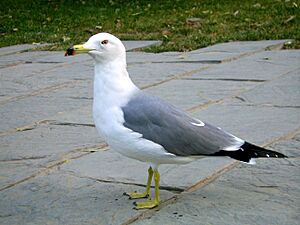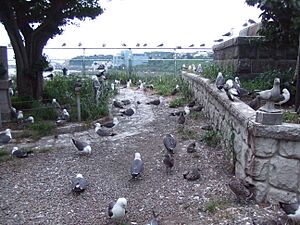Black-tailed gull facts for kids
Quick facts for kids Black-tailed gull |
|
|---|---|
 |
|
| Conservation status | |
| Scientific classification | |
| Genus: |
Larus
|
| Species: |
crassirostris
|
The black-tailed gull (Larus crassirostris) is a type of gull that lives along the coasts of East Asia. It's known for its black tail and a special call that sounds like a cat!
Contents
About the Black-tailed Gull
This gull is a medium-sized bird, usually about 46 centimeters (19 inches) long. Its wings can spread out to about 126–128 centimeters (around 50 inches). It has bright yellow legs and a unique red and black spot on the end of its beak.
Both male and female gulls look very similar, but the males are a bit bigger. It takes about four years for a young black-tailed gull to get its full adult feathers. As its name suggests, it has a distinct black tail.
People in Japan call this bird umineko, which means "sea cat," because of its cat-like call. In Korea, it's called gwaeng-yi gull, also meaning "cat" gull. In Hachinohe, Japan, the sounds of these gulls are so famous they are part of the "100 Soundscapes of Japan."
Where They Live
Black-tailed gulls live along the coasts of the East China Sea, Japan, Manchuria, and the Kuril Islands. Sometimes, they fly far away and are seen in places like Alaska, North America, and even the Philippines.
In Japan
These gulls are very common in Japan. They build their nests all the way from Hokkaido in the north to Western Kyushu in the south. Sometimes, their large numbers can even cause flights to be delayed at Haneda Airport in Tokyo!
One amazing place to see black-tailed gulls is at Kabushima, a small peninsula (it used to be an island) in Hachinohe, Aomori, Japan. There's a Shinto shrine there that was built by fishermen way back in 1269. People believe the black-tailed gull is a special messenger from the goddess of fishing.
For over 700 years, local people have respected, fed, and protected these gulls. Because of this, every summer, more than 40,000 black-tailed gulls come to nest and raise their young around the shrine and the area. The Japanese government has even named this place a National Natural Monument. The gulls here are very used to people and are a popular sight for tourists.
About 5,000 gulls also nest at Fumi-shima in Shimane Prefecture, close to Izumo Shrine. There's another big group of gulls at Teuri Island in Hokkaido.
In Korea
Black-tailed gulls are also common along the coast and on many islands in Korea. Over 20,000 of them live on Liancourt Rocks. Their numbers are growing there because there aren't many predators. In 2008, the black-tailed gull was even chosen as one of the mascots for Liancourt Rocks! Nando and Hongdo islands, which are also Korean natural monuments, are important places where these gulls breed.
In North America
It's quite rare to see a black-tailed gull in the United States. One was spotted in Burlington, Vermont, in October 2005. They have also been seen a few times in Illinois.
How They Live
Black-tailed gulls mostly eat small fish, molluscs (like snails or clams), crustaceans (like crabs), and leftover food scraps. They also eat dead animals. A study in Korea looked at what gulls ate and found that most of their diet was fish, with smaller amounts of crustaceans and land insects.
These gulls often follow ships and fishing boats to find food. They also sometimes try to steal food from other seabirds. Black-tailed gulls like to nest together in large groups, called colonies. These colonies usually start forming in mid-April. The female gulls lay 2 to 3 eggs by early June. The eggs hatch after about 24 days.
Black-tailed gulls use many different sounds to talk to each other. They have more than 10 different calls! Young gulls can recognize their parents by their voice and how they look when they are about 10 to 15 days old. They can also tell their brothers and sisters apart from other gulls.
- Alarm calls are like warning signals that tell others about danger or predators.
- Aggressive calls are used when they attack predators.
- Contact calls are used for everyday communication among themselves.
The most common cat-like sound, called the "mew call," is a type of contact call. They use it a lot, like when they come back to the nest after finding food, when they switch turns taking care of the eggs, or when they fly together in a group. The sound a young gull makes when it's hungry and the sound a female makes during mating are also contact calls.
Images for kids
-
Black-tailed Gull in Tokyo Bay
-
Black-tailed Gull in Hachinohe, Aomori







